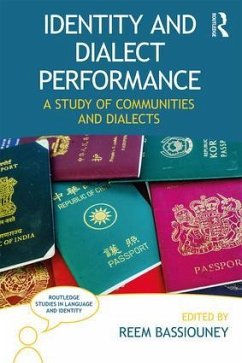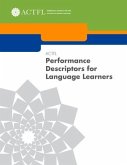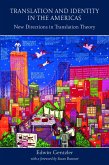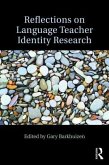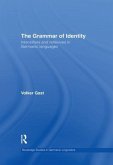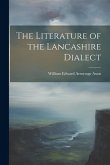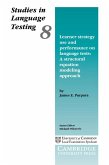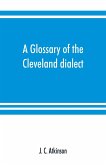Identity and Dialect Performance
A Study of Communities and Dialects
Herausgeber: Bassiouney, Reem
Identity and Dialect Performance
A Study of Communities and Dialects
Herausgeber: Bassiouney, Reem
- Broschiertes Buch
- Merkliste
- Auf die Merkliste
- Bewerten Bewerten
- Teilen
- Produkt teilen
- Produkterinnerung
- Produkterinnerung
Identity and Dialect Performance discusses the relationship between identity and dialects. It starts from the assumption that the use of dialect is not just a product of social and demographic factors, but can also be an intentional performance of identity. Dialect performance is related to identity construction and in a highly globalised world, the linguistic repertoire has increased rapidly, thereby changing our conventional assumptions about dialects and their usage. The key outstanding feature of this particular book is that it spans an extensive range of communities and dialects; Italy,…mehr
Andere Kunden interessierten sich auch für
![Actfl Performance Descriptors for Language Learners Actfl Performance Descriptors for Language Learners]() Paul SandrockActfl Performance Descriptors for Language Learners13,99 €
Paul SandrockActfl Performance Descriptors for Language Learners13,99 €![Translation and Identity in the Americas Translation and Identity in the Americas]() Edwin GentzlerTranslation and Identity in the Americas65,99 €
Edwin GentzlerTranslation and Identity in the Americas65,99 €![Reflections on Language Teacher Identity Research Reflections on Language Teacher Identity Research]() Reflections on Language Teacher Identity Research76,99 €
Reflections on Language Teacher Identity Research76,99 €![The Grammar of Identity The Grammar of Identity]() Volker GastThe Grammar of Identity78,99 €
Volker GastThe Grammar of Identity78,99 €![The Literature of the Lancashire Dialect The Literature of the Lancashire Dialect]() William Edward Armytage AxonThe Literature of the Lancashire Dialect17,99 €
William Edward Armytage AxonThe Literature of the Lancashire Dialect17,99 €![Learner Strategy Use and Performance on Language Tests Learner Strategy Use and Performance on Language Tests]() James E. PurpuraLearner Strategy Use and Performance on Language Tests74,99 €
James E. PurpuraLearner Strategy Use and Performance on Language Tests74,99 €![A glossary of the Cleveland dialect A glossary of the Cleveland dialect]() J. C. AtkinsonA glossary of the Cleveland dialect38,99 €
J. C. AtkinsonA glossary of the Cleveland dialect38,99 €-
-
-
Identity and Dialect Performance discusses the relationship between identity and dialects. It starts from the assumption that the use of dialect is not just a product of social and demographic factors, but can also be an intentional performance of identity. Dialect performance is related to identity construction and in a highly globalised world, the linguistic repertoire has increased rapidly, thereby changing our conventional assumptions about dialects and their usage. The key outstanding feature of this particular book is that it spans an extensive range of communities and dialects; Italy, Hong Kong, Morocco, Egypt, Syria, Japan, Germany, The Sudan, The Netherlands, Nigeria, Spain, US, UK, French Guiana, Colombia,and Libya.
Hinweis: Dieser Artikel kann nur an eine deutsche Lieferadresse ausgeliefert werden.
Hinweis: Dieser Artikel kann nur an eine deutsche Lieferadresse ausgeliefert werden.
Produktdetails
- Produktdetails
- Verlag: Routledge
- Seitenzahl: 390
- Erscheinungstermin: 8. November 2017
- Englisch
- Abmessung: 234mm x 156mm x 21mm
- Gewicht: 591g
- ISBN-13: 9781138241787
- ISBN-10: 1138241784
- Artikelnr.: 50051614
- Herstellerkennzeichnung
- Books on Demand GmbH
- In de Tarpen 42
- 22848 Norderstedt
- info@bod.de
- 040 53433511
- Verlag: Routledge
- Seitenzahl: 390
- Erscheinungstermin: 8. November 2017
- Englisch
- Abmessung: 234mm x 156mm x 21mm
- Gewicht: 591g
- ISBN-13: 9781138241787
- ISBN-10: 1138241784
- Artikelnr.: 50051614
- Herstellerkennzeichnung
- Books on Demand GmbH
- In de Tarpen 42
- 22848 Norderstedt
- info@bod.de
- 040 53433511
Reem Bassiouney is Professor of Linguistics at The American University of Cairo. Her recent book publications include Functions of Code-Switching in Egypt (2006), Arabic Sociolinguistics (2008), Arabic and the Media (2010, editor), Arabic language and Linguistics (2012, co-editor), Language and Identity in Modern Egypt (2014), and The Routledge Handbook of Arabic Linguistics (forthcoming, co-editor).
Contents
List of Figures
List of Tables
List of Contributors
Introduction
I. Dialects in Localised Delocalised Contexts
1. Nonstandard dialect and identity
John Edwards (St. Francis Xavier University)
2. The elusive dialect border
Dick Smakman & Marten van der Meulen (Universiteit Leiden)
3. Dialect performances in super diverse communities: the case for
ethnographic approaches to language variation
Anna De Fina (Georgetown University)
II. Nation-States and Identity Construction in Relation to a Standard and a
Dialect
4. The construction of linguistic borders and the rise of national identity
in South Sudan: some insights into Juba Arabic (árabi júba)
Stefano Manfredi (Centre national de la recherche scientifique,
SeDyL-CELIA)
5. From language to dialect and back: the case of Piedmontese
Mauro Tosco (Università degli Studi di Torino)
6. Darija and the construction of "Moroccanness"
Dominique Caubet (INALCO, Paris, and Centre Jacques Berque, CNRS - MAE,
Rabat)
7. 'Sloppy speech is like sloppy dress': folk attitudes towards
non-standard British English
Carmen Ebner (Universiteit Leiden)
III. Contact, Variation, Performance and Metalinguistic Discourse
8. From varieties in contact to the selection of linguistic features in
multilingual settings
Isabelle Leglise & Santiago Sanchez Moreano (Centre national de la
recherche scientifique, SeDyL-CELIA)
9. 'You live in the United States, you speak English', decían las maestras:
how New Mexican Spanish speakers enact, ascribe and reject ethnic
identities
Katherine O'Donnell Christoffersen & Naomi Shin (University of New Mexico)
10. The social meanings of Wolof and French: contact dialects, language
ideology, and competing modernities in Senegal
Fiona Mc Laughlin
11. The social value of variation in Tétouan and Ghomara (Northwestern
Morocco)
Angeles Vicente & Amina Naciri-Azzouz (Universidad de Zaragoza)
12. New presentations of self in everyday life: Linguistic transgressions
in England, Germany and Japan
Patrick Heinrich (Università Ca' Foscari)
13. Language and identity in Siwa Oasis: Indexing belonging, localness and
authenticity in a small minority community
Valentina Serreli
IV. The Media, Dialect Performance and Language Variation
14. Youtube Yinzers: Stancetaking and the performance of Pittsburghese
Scott F. Kielsing (University of Pittsburgh)
15. Performing Scottish identity on Screen: Language, Identity, and Humour
in Scottish Television Comedy
Natalie Braber (Nottingham Trent University)
16. Identity, Repertoire, and Performance: The Case of an Egyptian Poet
Reem Bassiouney (The American University in Cairo)
17. Ruination and amusement - dialect, youth and revolution in Naija
Anne Storch (Universität zu Köln)
18. Dialectal variation and identity in post-revolutionary Libyan media:
The case of Dragunov (2014)
Luca D'Anna (University of Mississippi)
19. The effect of TV and internal versus external contact on variation in
Syrian rural child language
Rania Habib (Syracuse University)
Index
List of Figures
List of Tables
List of Contributors
Introduction
I. Dialects in Localised Delocalised Contexts
1. Nonstandard dialect and identity
John Edwards (St. Francis Xavier University)
2. The elusive dialect border
Dick Smakman & Marten van der Meulen (Universiteit Leiden)
3. Dialect performances in super diverse communities: the case for
ethnographic approaches to language variation
Anna De Fina (Georgetown University)
II. Nation-States and Identity Construction in Relation to a Standard and a
Dialect
4. The construction of linguistic borders and the rise of national identity
in South Sudan: some insights into Juba Arabic (árabi júba)
Stefano Manfredi (Centre national de la recherche scientifique,
SeDyL-CELIA)
5. From language to dialect and back: the case of Piedmontese
Mauro Tosco (Università degli Studi di Torino)
6. Darija and the construction of "Moroccanness"
Dominique Caubet (INALCO, Paris, and Centre Jacques Berque, CNRS - MAE,
Rabat)
7. 'Sloppy speech is like sloppy dress': folk attitudes towards
non-standard British English
Carmen Ebner (Universiteit Leiden)
III. Contact, Variation, Performance and Metalinguistic Discourse
8. From varieties in contact to the selection of linguistic features in
multilingual settings
Isabelle Leglise & Santiago Sanchez Moreano (Centre national de la
recherche scientifique, SeDyL-CELIA)
9. 'You live in the United States, you speak English', decían las maestras:
how New Mexican Spanish speakers enact, ascribe and reject ethnic
identities
Katherine O'Donnell Christoffersen & Naomi Shin (University of New Mexico)
10. The social meanings of Wolof and French: contact dialects, language
ideology, and competing modernities in Senegal
Fiona Mc Laughlin
11. The social value of variation in Tétouan and Ghomara (Northwestern
Morocco)
Angeles Vicente & Amina Naciri-Azzouz (Universidad de Zaragoza)
12. New presentations of self in everyday life: Linguistic transgressions
in England, Germany and Japan
Patrick Heinrich (Università Ca' Foscari)
13. Language and identity in Siwa Oasis: Indexing belonging, localness and
authenticity in a small minority community
Valentina Serreli
IV. The Media, Dialect Performance and Language Variation
14. Youtube Yinzers: Stancetaking and the performance of Pittsburghese
Scott F. Kielsing (University of Pittsburgh)
15. Performing Scottish identity on Screen: Language, Identity, and Humour
in Scottish Television Comedy
Natalie Braber (Nottingham Trent University)
16. Identity, Repertoire, and Performance: The Case of an Egyptian Poet
Reem Bassiouney (The American University in Cairo)
17. Ruination and amusement - dialect, youth and revolution in Naija
Anne Storch (Universität zu Köln)
18. Dialectal variation and identity in post-revolutionary Libyan media:
The case of Dragunov (2014)
Luca D'Anna (University of Mississippi)
19. The effect of TV and internal versus external contact on variation in
Syrian rural child language
Rania Habib (Syracuse University)
Index
Contents
List of Figures
List of Tables
List of Contributors
Introduction
I. Dialects in Localised Delocalised Contexts
1. Nonstandard dialect and identity
John Edwards (St. Francis Xavier University)
2. The elusive dialect border
Dick Smakman & Marten van der Meulen (Universiteit Leiden)
3. Dialect performances in super diverse communities: the case for
ethnographic approaches to language variation
Anna De Fina (Georgetown University)
II. Nation-States and Identity Construction in Relation to a Standard and a
Dialect
4. The construction of linguistic borders and the rise of national identity
in South Sudan: some insights into Juba Arabic (árabi júba)
Stefano Manfredi (Centre national de la recherche scientifique,
SeDyL-CELIA)
5. From language to dialect and back: the case of Piedmontese
Mauro Tosco (Università degli Studi di Torino)
6. Darija and the construction of "Moroccanness"
Dominique Caubet (INALCO, Paris, and Centre Jacques Berque, CNRS - MAE,
Rabat)
7. 'Sloppy speech is like sloppy dress': folk attitudes towards
non-standard British English
Carmen Ebner (Universiteit Leiden)
III. Contact, Variation, Performance and Metalinguistic Discourse
8. From varieties in contact to the selection of linguistic features in
multilingual settings
Isabelle Leglise & Santiago Sanchez Moreano (Centre national de la
recherche scientifique, SeDyL-CELIA)
9. 'You live in the United States, you speak English', decían las maestras:
how New Mexican Spanish speakers enact, ascribe and reject ethnic
identities
Katherine O'Donnell Christoffersen & Naomi Shin (University of New Mexico)
10. The social meanings of Wolof and French: contact dialects, language
ideology, and competing modernities in Senegal
Fiona Mc Laughlin
11. The social value of variation in Tétouan and Ghomara (Northwestern
Morocco)
Angeles Vicente & Amina Naciri-Azzouz (Universidad de Zaragoza)
12. New presentations of self in everyday life: Linguistic transgressions
in England, Germany and Japan
Patrick Heinrich (Università Ca' Foscari)
13. Language and identity in Siwa Oasis: Indexing belonging, localness and
authenticity in a small minority community
Valentina Serreli
IV. The Media, Dialect Performance and Language Variation
14. Youtube Yinzers: Stancetaking and the performance of Pittsburghese
Scott F. Kielsing (University of Pittsburgh)
15. Performing Scottish identity on Screen: Language, Identity, and Humour
in Scottish Television Comedy
Natalie Braber (Nottingham Trent University)
16. Identity, Repertoire, and Performance: The Case of an Egyptian Poet
Reem Bassiouney (The American University in Cairo)
17. Ruination and amusement - dialect, youth and revolution in Naija
Anne Storch (Universität zu Köln)
18. Dialectal variation and identity in post-revolutionary Libyan media:
The case of Dragunov (2014)
Luca D'Anna (University of Mississippi)
19. The effect of TV and internal versus external contact on variation in
Syrian rural child language
Rania Habib (Syracuse University)
Index
List of Figures
List of Tables
List of Contributors
Introduction
I. Dialects in Localised Delocalised Contexts
1. Nonstandard dialect and identity
John Edwards (St. Francis Xavier University)
2. The elusive dialect border
Dick Smakman & Marten van der Meulen (Universiteit Leiden)
3. Dialect performances in super diverse communities: the case for
ethnographic approaches to language variation
Anna De Fina (Georgetown University)
II. Nation-States and Identity Construction in Relation to a Standard and a
Dialect
4. The construction of linguistic borders and the rise of national identity
in South Sudan: some insights into Juba Arabic (árabi júba)
Stefano Manfredi (Centre national de la recherche scientifique,
SeDyL-CELIA)
5. From language to dialect and back: the case of Piedmontese
Mauro Tosco (Università degli Studi di Torino)
6. Darija and the construction of "Moroccanness"
Dominique Caubet (INALCO, Paris, and Centre Jacques Berque, CNRS - MAE,
Rabat)
7. 'Sloppy speech is like sloppy dress': folk attitudes towards
non-standard British English
Carmen Ebner (Universiteit Leiden)
III. Contact, Variation, Performance and Metalinguistic Discourse
8. From varieties in contact to the selection of linguistic features in
multilingual settings
Isabelle Leglise & Santiago Sanchez Moreano (Centre national de la
recherche scientifique, SeDyL-CELIA)
9. 'You live in the United States, you speak English', decían las maestras:
how New Mexican Spanish speakers enact, ascribe and reject ethnic
identities
Katherine O'Donnell Christoffersen & Naomi Shin (University of New Mexico)
10. The social meanings of Wolof and French: contact dialects, language
ideology, and competing modernities in Senegal
Fiona Mc Laughlin
11. The social value of variation in Tétouan and Ghomara (Northwestern
Morocco)
Angeles Vicente & Amina Naciri-Azzouz (Universidad de Zaragoza)
12. New presentations of self in everyday life: Linguistic transgressions
in England, Germany and Japan
Patrick Heinrich (Università Ca' Foscari)
13. Language and identity in Siwa Oasis: Indexing belonging, localness and
authenticity in a small minority community
Valentina Serreli
IV. The Media, Dialect Performance and Language Variation
14. Youtube Yinzers: Stancetaking and the performance of Pittsburghese
Scott F. Kielsing (University of Pittsburgh)
15. Performing Scottish identity on Screen: Language, Identity, and Humour
in Scottish Television Comedy
Natalie Braber (Nottingham Trent University)
16. Identity, Repertoire, and Performance: The Case of an Egyptian Poet
Reem Bassiouney (The American University in Cairo)
17. Ruination and amusement - dialect, youth and revolution in Naija
Anne Storch (Universität zu Köln)
18. Dialectal variation and identity in post-revolutionary Libyan media:
The case of Dragunov (2014)
Luca D'Anna (University of Mississippi)
19. The effect of TV and internal versus external contact on variation in
Syrian rural child language
Rania Habib (Syracuse University)
Index

